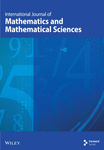New Numerical Solutions for Caputo–Fabrizio Fractional Differential Multidimensional Diffusion Problems
Abstract
This study examined the multidimensional fractional diffusion equations that characterize the density dynamics in a diffusing medium utilizing the exact and analytical Aboodh transform decomposition method (ATDM). The Caputo–Fabrizio (CF) derivative is utilized to account for the fractional derivative that is being employed here. The suggested method handles nonlinear terms by combining the Adomian decomposition method (ADM) with the Aboodh transform (AT) and Adomian polynomials. Since the AT can only be applied to linear equations, ADM is a helpful technique for estimating solutions to nonlinear differential equations. In nonlinear systems, multidimensional diffusion problems which account for the production of stripes in two-dimensional systems are important. Additionally, we used MATLAB to compute numerical and graphical data that illustrate how the close-form analytical solution compares to the precise solution. Promising and appropriate for addressing multidimensional diffusion problems with fractional derivatives are the obtained results. The key benefit is that our devised approach does not depend on presumptions or constraints on variables that skew the actual issue. Overcoming fluctuating constraints that can make it difficult to discover the answer and represent the problem depends much on this technique. In the domains of science and technology, the approach presented in this work offers exceptional computational accuracy and convenience of use for analyzing and resolving intricate phenomena associated with CF fractional nonlinear partial differential equations.
1. Introduction
A query from L’Hospital to Gottfried Wilhelm Leibniz in 1695 served as the inspiration for the development of the current, much debated notion of fractional calculus (FC). L’Hospital insisted on obtaining data regarding the derivative of order α = 1/2, laying the groundwork for a potent FC. Many scholars from other fields have recently been captivated by the discovery of symmetry-related FC, which enables them to contribute their unique viewpoints to solving practical issues. Due to its capacity to accurately characterize a wide range of nonlinear events, FC has drawn the attention of numerous authors in recent years. Differential equations of fractional order are extensions of conventional differential equations that show intrinsic and nonlocal effects on material properties. Reputable academics who have developed ground-breaking definitions and established the field of FC have thoroughly researched and explicated the idea of FC.
According to recent research, FC is more useful than classical calculus for solving the majority of challenging real-world issues. Over time, the application of FC in applied studies has grown and extended. Recent research has shown that nonlocal fractional operators exist even in the absence of a unique kernel, and has even predicted their occurrence. In addition, some fractional derivatives that are classified as local or nonlocal are defined differently than others, but they are distinguished by their capacity to characterize models. Among the most significant benefits offered by fractional derivatives are the exceptional memory and inheritance qualities displayed by numerous materials and processes.
The Caputo–Fabrizio (CF) derivative varies from standard fractional derivatives such as Riemann–Liouville (RL) and Caputo in numerous key areas, including kernel structure, memory effect, and physical interpretability [1, 2]. Nonlocal fractional derivatives offer a straightforward way to describe these properties along various processes. As a result, nonlocal fractional derivatives are definitely preferable to their local counterparts from a physical and practical standpoint. Particularly in cases involving nonlocal events, FC is applied in numerical techniques for differential equation solution. Engineering and physical processes have been most aptly modeled and described using fractional differential equations. Systems requiring precise modeling of damping are modeled faithfully using fractional differential models. Fractional derivatives can explain mechanisms displaying abnormal diffusion or wave propagation in several physical models. When modeling difficult materials, including viscoelastic materials, where conventional derivatives fall short in capturing the behavior, they are very helpful.
As a result, the CF derivative shows promise in handling this issue. With multiple applications in biology [3–7], electrodynamics [8], mechanics [9–11], nanotechnology [12], biotechnology [13], chaos theory [14], and many other fields [15–17], integral transforms are without a doubt one of the most practical and efficient methods in theoretical and applied mathematics. Different physical models have been solved in recent years using a variety of integral transforms, including the Sumudu transform (SMT) [18, 19], Shehu transform (ST) [20–22], Elzaki transform (ET) [23, 24], Laplace transform (LT) [25, 26], Aboodh transform method [27–29], differential transform method (DTM) [30–35] and these techniques include Adomian decomposition method (ADM) [36–38].
In this paper, we apply the Aboodh transform decomposition method (ATDM) to obtain analytical and numerical solutions of the CF fractional multidimensional diffusion equations. The advantage of this technique is that it uses two powerful methods together to obtain exact and approximate analytical solutions for nonlinear equations. It is worth mentioning strongly that the proposed method can reduce the computational volume compared to classical methods while maintaining high accuracy of the numerical result; dimensionality reduction implies an improvement in the performance of the approach. This work aims to examine the use of ATDM in the numerical resolution of multidimensional fractional diffusion equations, taking into account recent technical advancements and contrasting the findings with a contemporary methodology. The primary aim of this study is to provide the Aboodh Adomian transform technology. The second purpose is to implement the newly created hybrid method to address multidimensional fractional diffusion problems for the first time. A significant quantity of hitherto unexamined responses from the literature is identified, and their extensive graphical characteristics are illustrated. The primary aim of this study is to employ a novel hybrid technique, the ATDM, to get new numerical solutions for multidimensional fractional diffusion problems. Recently, there have been significant studies in the literature on the applications of FC [39–54]. This work significantly expands the scope and utility of fractional differential equations in scientific and engineering contexts by addressing the constraints of current numerical methods and fractional operators. It also establishes a framework that is both robust and adaptable for the resolution of multidimensional diffusion problems.
The current document is structured as follows: A summary of several fundamental definitions is given in Section 2. The study’s methodology is presented in Section 3. Three issues are answered in Section 4 to show how the methodology is applied. The results are presented in Section 5 and are further examined and commented. The primary findings are finally summarized in Section 6.
2. Preliminaries
Here, we present some basic definitions of CF that are important to our research.
Definition 1. CF fractional derivative [55] of order
Definition 2. The Caputo fractional derivative [56–58] of , with α > 0 representing the order of the derivative:
It is defined as.
Definition 3. The functions in set , as delineated, are examined by a novel transformation for exponential functions referred to as the Aboodh transformation [27–29].
It is defined as.
Definition 4. The inverse Aboodh transform of a function , t ∈ (0, ∞) if then
Theorem 1. Below are the Aboodh transformations for some special cases of the function [27–29].
3. Methods and Materials
3.1. Analysis of Convergence
Take into consideration all continuous functions on [0, T] with supremum norm and their Banach space C[0, T]. We take into consideration Ψ(x, t), Ψn(x, t) ∈ C[0, T] throughout this section.
Theorem 2. The Aboodh transform of the CF fractional derivative [61, 62] of order α, denoted as A{h(s)}, where h(t) is the function in question;
Theorem 3 (Uniqueness theorem [63–65]). The solution for the nonlinear fractional differential equation (1) derived via ATDM is unique for 0 < ϱ < 1.
Therefore, |Ψ − Φ| = 0, as 0 < ϱ < 1. Consequently, Ψ = Φ. This demonstrates the solution’s distinctiveness.
Theorem 4 (Convergence theorem [63–66]). Assume that X is a Banach space and H : X⟶X is a nonlinear mapping. If the inequality
Proof 2. Consider a Banach space (C[J], ‖.‖) comprising all continuous functions on J, with the norm defined as ‖h(ξ)‖ = maxξ∈J|h(ξ)|.
Although ‖Ψ1 − Ψ0‖ < ∞, as m approaches infinity, ‖Ψm − Ψn‖ approaches zero. Consequently, the sequence {Ψn} is a Cauchy sequence in C[J], and is therefore convergent.
4. Applications of ATDM
In this section, we apply the Aboodh transform decomposition approach to multidimensional fractional diffusion equations [67], in particular the nonlinearity is controlled by using Adomian polynomials. The solutions and absolute errors will then be compared with exact solution by evaluating the accuracy of the proposed method.
Example 1.
Bn ve Cn Adomian polynomials.
It converges because its values are less than 1 [68, 69].
For fractional derivative values α = 1, Figure 1 displays the exact solution, the 3D graphs of the resulting absolute error, and the results obtained from the ATDM method. It is evident that the results obtained are entirely consistent.
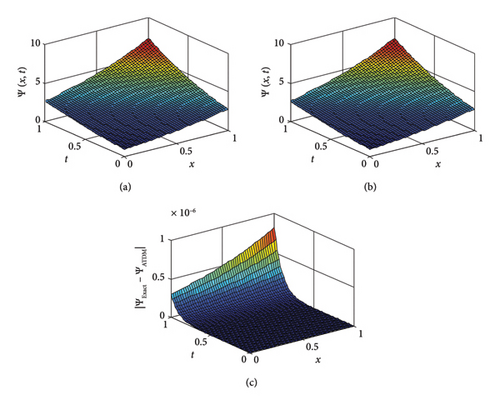
The results obtained from the ATDM method for fractional derivative values α = 0.6 and 0.8 are shown in Figure 2. It is seen that the maximum value of Ψ(x, t) increases when the α value decreases from 0.8 to 0.6.
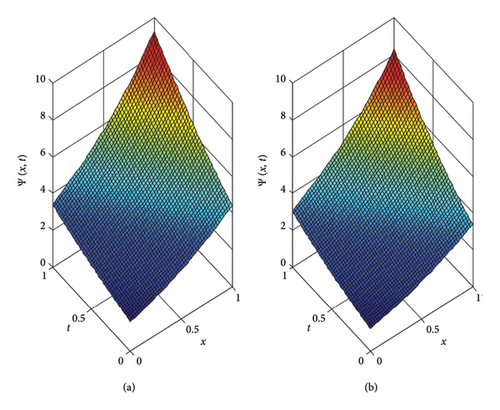
Contour diagrams of exact and approximate solutions for α = 1, x ∈ [0, 2] and t ∈ [0, 2] values are depicted in Figure 3. The graphs show that the results are extremely similar.
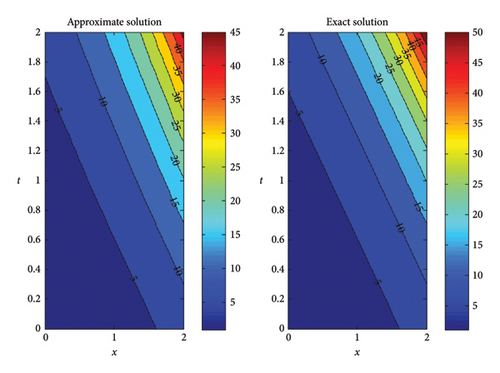
In Figure 4, when we look at Ψ(x, 3) in the x ∈ [0, 1] range, it is observed that as the order of the fractional derivative decreases, the Ψ(x, 3) solutions decrease. On the contrary, when we look at Ψ(3, t) in the t ∈ [0, 1] range, it is observed that as the order of the fractional derivative decreases, the Ψ(3, t) solutions increase.
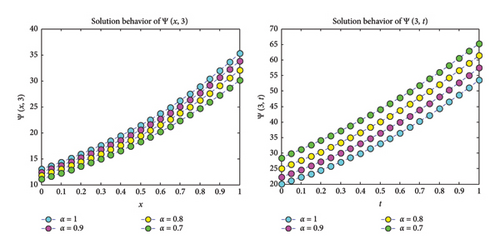
In Table 1, the values for different values of (x, t) and α = 0.85 and 1 are calculated, and the exact solution is compared with the proposed ATDM method at α = 1, and the results obtained are extremely promising.
| (x, t) | α = 0.85 | α = 1 | Exact | |ΨEx.−ΨATDM| |
|---|---|---|---|---|
| (1, 0.5) | 5.166936999 | 4.481689068 | 4.481689070 | 0.2000000000 10−8 |
| (1, 1) | 8.058119957 | 7.389056028 | 7.389056099 | 0.7100000000 10−7 |
| (1, 1.5) | 12.07857912 | 12.18248724 | 12.18249396 | 0.6720000000 10−5 |
| (1, 2) | 17.43698509 | 20.08537004 | 20.08553692 | 0.0001668800000 |
| (1, 2.5) | 24.34200848 | 33.11341112 | 33.11545196 | 0.002040840000 |
| (2, 0.5) | 14.04519096 | 12.18249396 | 12.18249396 | 0 |
| (2, 1) | 21.90424105 | 20.08553674 | 20.08553692 | 0.1800000000 10−6 |
| (2, 1.5) | 32.83298214 | 33.11543369 | 33.11545196 | 0.00001827000000 |
| (2, 2) | 47.39863973 | 54.59769642 | 54.59815003 | 0.0004536100000 |
| (2, 2.5) | 66.16843934 | 90.01158374 | 90.01713130 | 0.005547560000 |
Example 2.
Using the Aboodh transform decomposition approach, the CF fractional partial differential equation Ψ(x, y, 0) = sin x cos y may be solved given the initial condition.
It converges because its values are less than 1 [68, 69].
For fractional derivative parameters α = 1 and t = 0.5, Figure 5 illustrates the precise solution, the three-dimensional representations of the resultant absolute error, and the outcomes derived from the ATDM approach. The data obtained are unequivocally consistent.
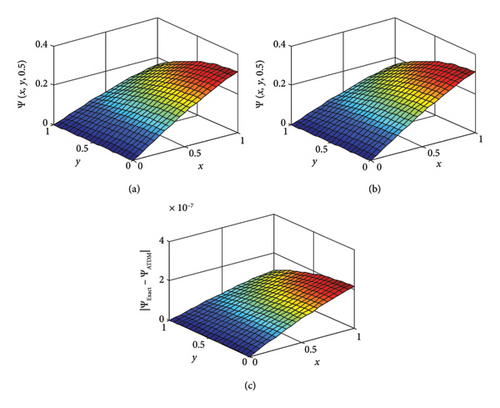
In Figure 6, when the α value diminishes from 1 to 0.7 inside the interval x ∈ [0, 1], it is observed that the Ψ(x, 4, 4) solutions decline as the order of the fractional derivative lowers. As the alpha value diminishes from 1 to 0.7 within the interval y ∈ [0, 1], the Ψ(4, y, 4) solutions are observed to decline with the reduction in the order of the fractional derivative. As the alpha value diminishes from 1 to 0.7 within the interval t ∈ [0, 1], the Ψ(4, 4, t) solutions are observed to decline with a reduction in the order of the fractional derivative.

In Table 2, values for α = 0.85 and 1 are computed and the precise solution is compared with the ATDM approach suggested for α = 1 and the resulting results show great agreement when t changes in the range of [0, 1].
| t | α = 0.85 | α = 1 | Exact solution | |ΨEx − ΨATDM| |
|---|---|---|---|---|
| 0.1 | 0.1834314950 | 0.2311450788 | 0.2311450787 | 0.1000000000 10−9 |
| 0.2 | 0.1508807502 | 0.1892455844 | 0.1892455844 | 0 |
| 0.3 | 0.1163718256 | 0.1549411794 | 0.1549411798 | 0.4000000000 10−8 |
| 0.4 | 0.07851767673 | 0.1268551010 | 0.1268551088 | 0.7800000000 10−7 |
| 0.5 | 0.03593125898 | 0.1038601075 | 0.1038601788 | 0.7130000000 10−6 |
| 0.6 | −0.01277447132 | 0.08503308842 | 0.08503352239 | 0.4339700000 10−5 |
| 0.7 | −0.06898655893 | 0.06961756571 | 0.06961955981 | 0.1994100000 10−5 |
| 0.8 | −0.1340920473 | 0.05699221715 | 0.05699967465 | 0.7457500000 10 |
| 0.9 | −0.2094779817 | 0.04664355553 | 0.04666738654 | 0.00002383101000 |
| 1 | −0.2965314059 | 0.03814075272 | 0.03820802452 | 0.00006727180000 |
Example 3.
Utilizing the ATDM, solve the CF fractional multidimensional partial differential equation for the initial condition Ψ(x, y, z, 0) = sin x sin y sin z.
It converges because its values are less than 1 [68, 69].
The 3D graphs of Ψ(0.2, y, 0.2, t) are depicted in Figure 7 for α values of 0.8, 0.9, and 1, as well as for x values of 0.2 and z values of 0.2. It has been noted that the solutions increase in tandem with the alpha fractional derivative value.
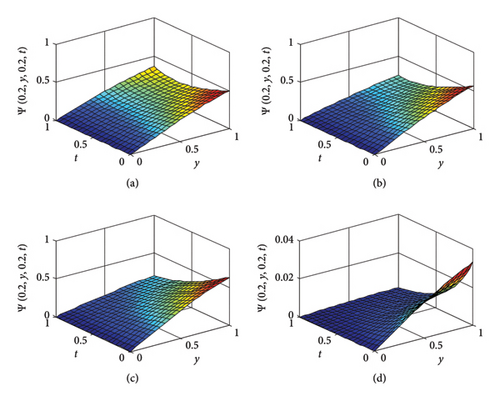
5. Results and Discussions
In this paper, we presented Tables 1 and 2, which show that the simulation results obtained with the proposed technique are close to the exact solution for fractional order diffusion equations. Figure 1 shows the nature of the 3D plots of the approximate exact solution and absolute error of Example 1. Figure 2 examines the 3D nature of the approximate solution for different values of α. Contour plots of the exact and approximate solutions are given in Figure 3. Figure 4 presents the 2D plots of the approximate solution plots of Ψ(x, 3) and Ψ(3, t) for different values of α. Figure 5 shows the nature of the 3D plots of the approximate exact solution and absolute error of Example 2. Figure 6 presents the 2D plots of the approximate solution plots of Ψ(x, 4, 4), Ψ(4, y, 4) and Ψ(4, 4, t) for different values of alpha. Figure 7 depicts the dynamic behavior of the approximate and exact solutions of Example 3 at x = 0.20 and z = 0.20. From the graphical solutions, we observe that the approximate solutions closely match the exact solutions at α = 1.
6. Conclusion
In this study, we effectively employed a hybrid technique known as ATDM to investigate the multidimensional fractional order diffusion problem with the CF derivative. The existence and uniqueness of the proposed approach are established by the fixed point theorem. We solved three types of fractional order diffusion equations to demonstrate the accuracy and effectiveness of the proposed scheme. The results of the approximate solutions that are obtained using the ATDM are exceedingly similar to the exact solution. The results show how reliable and accurate the suggested technique is computationally. The proposed method is highly applicable to a diverse array of engineering disciplines due to its capacity to simulate memory effects, nonlocal properties, and multivariate diffusion processes. The method equips engineers with a potent instrument to design and optimize systems, thereby advancing both theoretical comprehension and practical innovation, spanning from thermal management and fluid flow to biomedical engineering and environmental modeling. The ATDM is distinguished by its capacity to provide precise, analytical solutions with minimal computational effort, while simultaneously effectively addressing complex multidimensional fractional diffusion problems. In contrast to conventional numerical or analytical methods, it is a potent instrument due to its robustness, versatility, and efficiency. The significance of ATDM in the advancement of FC and its applications is illustrated by these advantages.
Conflicts of Interest
The authors declare no conflicts of interest.
Funding
Open access funding was provided and organized under the TUBITAK-Ulakbim + Wiley UAE agreement.
Open Research
Data Availability Statement
Data sharing is not applicable to this article as no new data were created or analyzed in this study.



